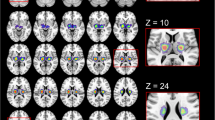Abstract
The imaging definition of lacunar infarcts is variable, particularly regarding their size and the presence of cavitation. We investigated the changes of diameter and evolution pattern of acute lacunar infarcts, and the factors associated with the evolution pattern. Patients with acute single subcortical hemispheric or brainstem ischemic lesions of penetrating arterial territories were included. Maximal diameters on initial diffusion-weighted image (DWI) and follow-up fluid-attenuated inversion recovery image (FLAIR), which performed > 12 months after initial DWI, were semi-automatically measured. Clinical characteristics were compared according to evolution patterns on follow-up FLAIR, classified as cavitated, focal lesion without cavitation, and disappeared. Five hundred nine patients were included. Mean time to follow-up was 31.3 ± 13.7 months. Mean diameter of acute lacunar lesions decreased from 12.9 ± 4.4 to 8.5 ± 4.8 mm during follow-up. Lesions of 58.2% patients remained as cavitated, 18.3% as focal lesion without cavitation, and 23.6% disappeared. Initial NIHSS score (p = 0.005), diameter of initial lesion (p < 0.001), number of slices showing acute lesion on DWI (p < 0.001), progression of white matter lesion (p < 0.001), number of acute lesions involving gray matter (p = 0.008) and lesion location (p < 0.001) were different among three groups. After adjustment for covariates, diameter of the acute lesion, initial number of old lacunes, and anterior lesion location were associated with the appearance of cavitation. Initial lesion diameter and posterior lesion location were associated with the disappearance. We observed reduction of the acute lacunar lesion diameter in 86%. There were predictive factors of disappearance and cavitation of acute lacunar infarction.

Similar content being viewed by others
References
White H, Boden-Albala B, Wang C, Elkind MS, Rundek T, Wright CB, Sacco RL (2005) Ischemic stroke subtype incidence among whites, blacks, and Hispanics: the Northern Manhattan Study. Circulation 111:1327–1331. https://doi.org/10.1161/01.cir.0000157736.19739.d0
Sacco S, Marini C, Totaro R, Russo T, Cerone D, Carolei A (2006) A population-based study of the incidence and prognosis of lacunar stroke. Neurology 66:1335–1338. https://doi.org/10.1212/01.wnl.0000210457.89798.0e
Petty GW, Brown RD Jr, Whisnant JP, Sicks JD, O’Fallon WM, Wiebers DO (1999) Ischemic stroke subtypes: a population-based study of incidence and risk factors. Stroke 30:2513–2516
Fisher CM (1965) Lacunes: small, deep cerebral infarcts. Neurology 15:774–784
Potter GM, Marlborough FJ, Wardlaw JM (2011) Wide variation in definition, detection, and description of lacunar lesions on imaging. Stroke 42:359–366. https://doi.org/10.1161/strokeaha.110.594754
Lee KJ, Jung H, Oh YS, Lim EY, Cho AH (2017) The fate of acute lacunar lesions in terms of shape and size. J Stroke Cerebrovasc Dis 26:1254–1257. https://doi.org/10.1016/j.jstrokecerebrovasdis.2017.01.017
Potter GM, Doubal FN, Jackson CA, Chappell FM, Sudlow CL, Dennis MS, Wardlaw JM (2010) Counting cavitating lacunes underestimates the burden of lacunar infarction. Stroke 41:267–272. https://doi.org/10.1161/strokeaha.109.566307
Moreau F, Patel S, Lauzon ML et al (2012) Cavitation after acute symptomatic lacunar stroke depends on time, location, and MRI sequence. Stroke 43:1837–1842. https://doi.org/10.1161/strokeaha.111.647859
Guadagno JV, Warburton EA, Aigbirhio FI et al (2004) Does the acute diffusion-weighted imaging lesion represent penumbra as well as core? A combined quantitative PET/MRI voxel-based study. J Cereb Blood Flow Metab 24:1249–1254. https://doi.org/10.1097/01.wcb.0000141557.32867.6b
Kidwell CS, Alger JR, Saver JL (2003) Beyond mismatch: evolving paradigms in imaging the ischemic penumbra with multimodal magnetic resonance imaging. Stroke 34:2729–2735. https://doi.org/10.1161/01.str.0000097608.38779.cc
Koch S, McClendon MS, Bhatia R (2011) Imaging evolution of acute lacunar infarction: leukoariosis or lacune? Neurology 77:1091–1095. https://doi.org/10.1212/WNL.0b013e31822e1470
Kim BJ, Lee EJ, Kwon SU et al (2018) Prevention of cardiovascular events in Asian patients with ischaemic stroke at high risk of cerebral haemorrhage (PICASSO): a multicentre, randomised controlled trial. Lancet Neurol 17:509–518. https://doi.org/10.1016/s1474-4422(18)30128-5
Hong KS, Kim BJ, Lee JY, Kwon SU (2015) Rationale and design of the prevention of cardiovascular events in ischemic stroke patients with high risk of cerebral hemorrhage (PICASSO) study: a randomized controlled trial. Int J Stroke 10:1153–1158. https://doi.org/10.1111/ijs.12519
Pantoni L, Basile AM, Pracucci G et al (2005) Impact of age-related cerebral white matter changes on the transition to disability—the LADIS study: rationale, design and methodology. Neuroepidemiology 24:51–62. https://doi.org/10.1159/000081050
Wahlund LO, Barkhof F, Fazekas F et al (2001) A new rating scale for age-related white matter changes applicable to MRI and CT. Stroke 32:1318–1322
Schmidt R, Berghold A, Jokinen H et al (2012) White matter lesion progression in LADIS: frequency, clinical effects, and sample size calculations. Stroke 43:2643–2647. https://doi.org/10.1161/strokeaha.112.662593
Gregoire SM, Chaudhary UJ, Brown MM, Yousry TA, Kallis C, Jager HR, Werring DJ (2009) The Microbleed Anatomical Rating Scale (MARS): reliability of a tool to map brain microbleeds. Neurology 73:1759–1766. https://doi.org/10.1212/WNL.0b013e3181c34a7d
Poirier J, Derouesne C (1984) Cerebral lacunae. A proposed new classification. Clin Neuropathol 3:266
Gouw AA, van der Flier WM, van Straaten EC et al (2008) Reliability and sensitivity of visual scales versus volumetry for evaluating white matter hyperintensity progression. Cerebrovasc Dis 25:247–253. https://doi.org/10.1159/000113863
Arboix A, López-Grau M, Casasnovas C, García-Eroles L, Massons J, Balcells M (2006) Clinical study of 39 patients with atypical lacunar syndrome. J Neurol Neurosurg Psychiatry 77:381–384. https://doi.org/10.1136/jnnp.2005.071860
Blanco-Rojas L, Arboix A, Canovas D, Grau-Olivares M, Oliva Morera JC, Parra O (2013) Cognitive profile in patients with a first-ever lacunar infarct with and without silent lacunes: a comparative study. BMC Neurol 16:13:203. https://doi.org/10.1186/1471-2377-13-203
Acknowledgements
PICASSO study was supported by Korea Otsuka Pharmaceutical Company. SU Kwon received Grants from Korea Otsuka Pharmaceutical Company.
Author information
Authors and Affiliations
Consortia
Corresponding author
Ethics declarations
Conflicts of interest
The authors have no conflicts of interest to report.
Ethical standards
This study was approved by the ethics committee of each participating center and all participants were enrolled after written informed consent was obtained.
Rights and permissions
About this article
Cite this article
Kwon, H.S., Cho, AH., Lee, M.H. et al. Evolution of acute lacunar lesions in terms of size and shape: a PICASSO sub-study. J Neurol 266, 766–772 (2019). https://doi.org/10.1007/s00415-019-09201-7
Received:
Revised:
Accepted:
Published:
Issue Date:
DOI: https://doi.org/10.1007/s00415-019-09201-7




